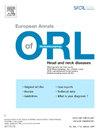贝伐珠单抗鼻喷雾剂治疗奥斯勒-韦伯-伦杜病鼻衄。EROSB研究:确定有效剂量。
IF 2.4
4区 医学
Q2 OTORHINOLARYNGOLOGY
European Annals of Otorhinolaryngology-Head and Neck Diseases
Pub Date : 2025-03-01
DOI:10.1016/j.anorl.2024.10.006
引用次数: 0
摘要
治疗奥斯勒-韦伯-伦杜病(OWRD)鼻出血是一项治疗难题。鼻内抗血管生成喷雾剂是一种很有前景的解决方案,但需要科学验证,因此我们开展了本研究:主要目的是确定贝伐珠单抗鼻内喷雾剂治疗OWRD鼻衄的最小有效剂量:即与纳入前一个月相比,60%的患者在治疗1个月后鼻出血次数减少≥50%的剂量。次要目标是评估 3 个月和 6 个月的疗效以及鼻出血次数和影响的进展,并记录药代动力学:这项名为EROSB(使用贝伐珠单抗鼻内喷雾剂治疗OWRD患者鼻衄)的研究属于法国医院临床研究计划(PHRC-I 2013),由地区间临床研究与创新小组(GIRCI)选定。这是一项I/II期前瞻性单盲研究,以10个队列为基础,每个队列3名患者,采用持续再评估法(CRM)确定贝伐珠单抗的最小有效剂量:由于难以招募到足够的患者,研究在纳入 15 名受试者后停止。CRM 方法确定 64 毫克为最小有效剂量。然而,由于受试者人数较少,这一结果无法解释:EROSB研究并未成功确定贝伐珠单抗鼻内喷雾剂的最小有效剂量,与纳入前一个月相比,该剂量可减少鼻出血次数。不过,初步结果表明,该物质几乎没有通过全身。本文章由计算机程序翻译,如有差异,请以英文原文为准。
Treatment of epistaxis in Osler-Weber-Rendu disease by bevacizumab nasal spray. The EROSB study: Determining the effective dose
Treatment of nosebleeds in Osler-Weber-Rendu disease (OWRD) is a therapeutic challenge. Intranasal anti-angiogenic sprays are a promising solution, requiring scientific validation, leading us to conduct the present study.
Objective
The main objective was to determine the minimum effective dose of bevacizumab by intranasal spray to treat epistaxis in OWRD: i.e., the dose resulting in ≥ 50% reduction in the number of nosebleeds at 1 month of treatment compared to the month prior to inclusion for 60% of patients. The secondary objectives were to assess treatment efficacy at 3 and 6 months and progression in the number and impact of nosebleeds, and to document pharmacokinetics.
Materials and methods
The study, named EROSB (treatment of epistaxis in patients with OWRD using a bevacizumab intranasal spray), under the French Hospitals Clinical Research Program (PHRC-I 2013), was selected by the Inter-regional Clinical Research and Innovation Group (GIRCI). It was a phase I/II prospective single-blind study based on 10 cohorts of 3 patients each, using the Continual Reassessment Method (CRM) to determine the minimum effective dose of bevacizumab.
Results
Due to difficulties in recruiting enough patients, the study was stopped after inclusion of 15 subjects. The CRM method identified 64 mg as the minimum effective dose. However, this result is not interpretable due to the small number of subjects.
Conclusion
The EROSB study did not succeed in identifying a minimum effective dose of bevacizumab, administered as intranasal spray that could reduce the number of nosebleeds compared to the month prior to inclusion. However, the initial results indicated almost no systemic passage of the substance.
求助全文
通过发布文献求助,成功后即可免费获取论文全文。
去求助
来源期刊

European Annals of Otorhinolaryngology-Head and Neck Diseases
OTORHINOLARYNGOLOGY-
CiteScore
3.70
自引率
28.00%
发文量
97
审稿时长
12 days
期刊介绍:
European Annals of Oto-rhino-laryngology, Head and Neck diseases heir of one of the oldest otorhinolaryngology journals in Europe is the official organ of the French Society of Otorhinolaryngology (SFORL) and the the International Francophone Society of Otorhinolaryngology (SIFORL). Today six annual issues provide original peer reviewed clinical and research articles, epidemiological studies, new methodological clinical approaches and review articles giving most up-to-date insights in all areas of otology, laryngology rhinology, head and neck surgery. The European Annals also publish the SFORL guidelines and recommendations.The journal is a unique two-armed publication: the European Annals (ANORL) is an English language well referenced online journal (e-only) whereas the Annales Françaises d’ORL (AFORL), mail-order paper and online edition in French language are aimed at the French-speaking community. French language teams must submit their articles in French to the AFORL site.
Federating journal in its field, the European Annals has an Editorial board of experts with international reputation that allow to make an important contribution to communication on new research data and clinical practice by publishing high-quality articles.
 求助内容:
求助内容: 应助结果提醒方式:
应助结果提醒方式:


